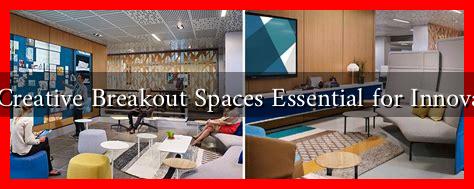-
Table of Contents
Are Creative Breakout Spaces Essential for Innovation?
In today’s fast-paced business environment, innovation is not just a buzzword; it is a necessity for survival. Companies are constantly seeking new ways to foster creativity and collaboration among their employees. One of the most effective strategies that have emerged is the creation of creative breakout spaces. But are these spaces truly essential for innovation? This article explores the significance of creative breakout spaces, their impact on innovation, and real-world examples that illustrate their effectiveness.
The Role of Creative Breakout Spaces
Creative breakout spaces are designated areas within a workplace designed to encourage informal interactions, brainstorming, and creative thinking. Unlike traditional office environments, these spaces often feature comfortable seating, vibrant colors, and various tools to stimulate creativity. The primary goal is to provide employees with an environment that breaks the monotony of their daily tasks and inspires innovative thinking.
Why Breakout Spaces Matter
Research indicates that the physical environment significantly influences creativity and productivity. Here are some reasons why creative breakout spaces are essential for innovation:
- Encourages Collaboration: Breakout spaces facilitate spontaneous interactions among employees from different departments, leading to diverse ideas and perspectives.
- Reduces Stress: A relaxed environment can help alleviate stress, allowing employees to think more freely and creatively.
- Stimulates Creativity: Unique designs and flexible layouts can inspire new ways of thinking and problem-solving.
- Enhances Employee Satisfaction: Providing spaces for relaxation and creativity can improve overall job satisfaction, leading to higher retention rates.
Case Studies: Success Stories
Several companies have successfully integrated creative breakout spaces into their work environments, yielding impressive results:
Google is renowned for its innovative work culture, which includes a variety of creative spaces. Their offices feature game rooms, nap pods, and open areas designed for collaboration. According to a study by the Forbes Technology Council, these spaces have significantly contributed to Google’s ability to innovate rapidly and maintain its competitive edge.
Airbnb
Airbnb’s headquarters in San Francisco includes various breakout spaces that reflect the company’s commitment to creativity and community. The design encourages employees to collaborate and share ideas, which has led to numerous successful projects and initiatives. A report from Harvard Business Review highlights how these spaces have fostered a culture of innovation within the company.
Statistics Supporting Breakout Spaces
Several studies have quantified the benefits of creative breakout spaces:
- A study by the Gartner Group found that 75% of organizations that implemented creative spaces reported increased employee engagement.
- According to a report by JLL, 60% of employees believe that a well-designed workspace enhances their productivity.
Conclusion: The Future of Workspaces
As the workplace continues to evolve, the importance of creative breakout spaces cannot be overstated. They play a crucial role in fostering innovation by encouraging collaboration, reducing stress, and stimulating creativity. Companies like Google and Airbnb serve as prime examples of how these spaces can lead to significant business success. As organizations strive to remain competitive in an ever-changing landscape, investing in creative breakout spaces may very well be the key to unlocking their full innovative potential.
In summary, creative breakout spaces are not just a trend; they are essential for cultivating an innovative culture that can drive business success. By prioritizing these environments, companies can empower their employees to think outside the box and contribute to a more dynamic and creative workplace.

